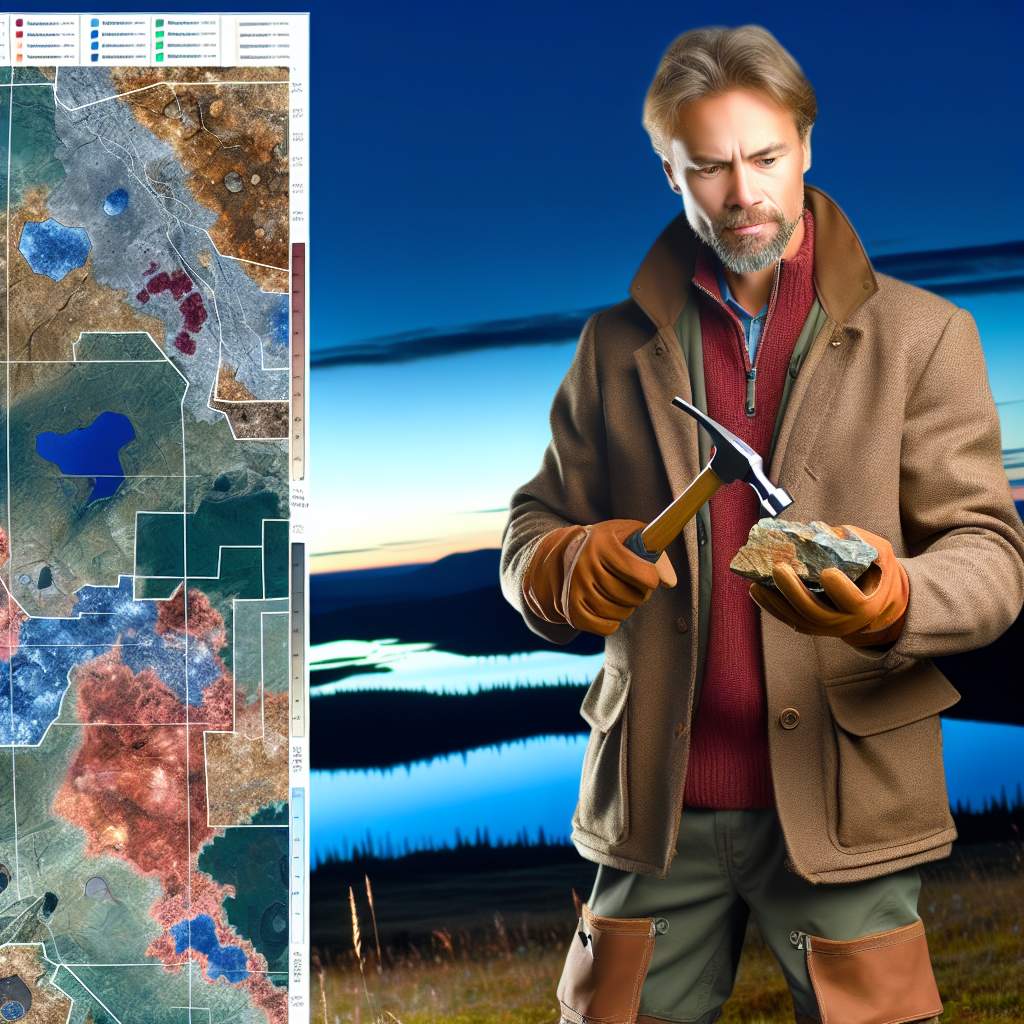Overview of Natural Resource Management and the Role of Geologists
Natural resource management uses various practices to manage resources sustainably.
These resources include water, minerals, forests, and land.
Effective management ensures availability for future generations.
Geologists play a crucial role in this management process.
They analyze the Earth’s materials to assess resource availability.
Understanding the Contribution of Geologists
Geologists study geological formations and processes.
They provide insights into mineral deposits and groundwater sources.
Moreover, their work informs decision-making for resource exploration.
Their expertise ensures that extraction methods are sustainable.
Thus, geologists help mitigate environmental impacts from resource use.
Collaboration with Other Disciplines
Geologists often collaborate with engineers and environmental scientists.
This teamwork enhances the effectiveness of resource management strategies.
For instance, geologists provide critical data for construction projects.
They also help assess landslide risks and other geological hazards.
Such collaborations lead to safer and more efficient resource utilization.
Monitoring and Environmental Impact Assessment
Geologists conduct monitoring to evaluate the effects of resource extraction.
This involves studying changes in landscapes and ecosystems.
They assess the potential for contamination of groundwater resources.
Through environmental impact assessments, geologists inform policy-makers.
This ensures regulations are based on scientific evidence and data.
Education and Public Awareness
Geologists also engage in public education about natural resources.
They raise awareness of sustainable practices and conservation efforts.
Educational initiatives help communities understand geological processes.
Knowledge about resources can foster community stewardship.
Ultimately, informed citizens can participate in sustainable resource management.
Unlock Your Career Potential
Visualize a clear path to success with our tailored Career Consulting service. Personalized insights in just 1-3 days.
Get StartedUnderstanding Geological Formations and Their Influence on Resource Availability
Role of Geologists in Resource Assessment
Geologists play a vital role in assessing natural resources.
They analyze the geological formations to determine resource types.
Through their work, they identify valuable minerals and fossil fuels.
This assessment helps in sustainable resource management.
Influence of Geological Structures
The structure of the Earth’s crust significantly affects resource availability.
Different geological formations contain distinct types of resources.
For example, sedimentary rocks often hold oil and gas deposits.
In contrast, igneous rocks may house precious metals like gold.
Mapping Geological Resources
Geologists utilize advanced mapping techniques to locate resources.
They employ tools such as Geographic Information Systems (GIS).
This technology enhances the accuracy of resource identification.
Consequently, it aids in planning extraction processes.
Environmental Considerations
Geologists also consider environmental impacts when managing resources.
They study how resource extraction influences local ecosystems.
By doing so, they promote environmentally responsible practices.
Mitigating negative impacts is essential for sustainable development.
Collaboration with Other Disciplines
Geologists work alongside engineers, ecologists, and policy makers.
This collaboration ensures a comprehensive approach to resource management.
They share data and insights to enhance decision-making processes.
This teamwork leads to more sustainable solutions for resource extraction.
Methods Used by Geologists to Locate and Assess Natural Resources
Geological Surveys
Geologists conduct geological surveys to collect data on the Earth’s materials.
They use various techniques to map mineral distribution across regions.
This helps in locating potential natural resource deposits.
Remote Sensing
Remote sensing techniques allow geologists to analyze land features from a distance.
They use satellite imagery to assess geological formations and mineral deposits.
Such technology enhances the efficiency of resource assessment.
Field Studies
Field studies involve direct observation and sampling of geological formations.
Geologists collect rock and soil samples to analyze their composition.
This on-site work provides valuable data for resource management strategies.
Geophysical Methods
Geophysical methods include techniques such as seismic, magnetic, and electrical surveys.
These methods help detect subsurface structures without extensive excavation.
Geologists interpret the data to identify potential resource deposits.
Drilling Programs
Drilling programs allow geologists to retrieve core samples from deeper layers of the Earth.
These samples provide insights into the geological history of an area.
Additionally, they help estimate the quantity and quality of resources available.
Environmental Assessments
Geologists perform environmental assessments to understand the impact of resource extraction.
They evaluate how mining activities affect ecosystems and local communities.
This knowledge informs sustainable resource management practices.
Data Analysis and Modeling
Geologists utilize data analysis software to model resource distribution.
These models predict the location and accessibility of natural resources.
They play a crucial role in strategic planning for resource development.
Collaboration with Other Disciplines
Geologists often collaborate with engineers, environmental scientists, and policy-makers.
This multidisciplinary approach enhances the effectiveness of resource management strategies.
It ensures a holistic understanding of the challenges involved.
Uncover the Details: Key Challenges Facing Ecologists in Canada
The Impact of Geologist-Led Studies on Sustainable Resource Extraction
Enhancing Resource Understanding
Geologists play a crucial role in understanding natural resources.
They conduct detailed geological surveys to assess resource availability.
Studies reveal the spatial distribution of minerals and fossil fuels.
Such knowledge aids managers to make informed extraction decisions.
Promoting Sustainable Practices
Geologist-led initiatives emphasize sustainable extraction methods.
They develop strategies that minimize environmental impact.
For instance, they advocate for less invasive drilling techniques.
Additionally, they highlight the importance of habitat conservation.
Risk Assessment and Mitigation
Geologists assess potential risks associated with resource extraction.
They identify geological hazards that could threaten projects.
By doing so, they help prevent costly accidents and environmental damage.
Furthermore, they recommend mitigation strategies to address these risks.
Collaboration with Stakeholders
Geologists collaborate with various stakeholders in resource management.
They engage with government agencies, communities, and industries.
This collaboration fosters a holistic approach to resource planning.
Joint efforts result in sustainable policies and practices.
Enhancing Technological Integration
Geologists utilize advanced technologies in resource exploration.
Tools such as Geographic Information Systems (GIS) are essential.
These technologies enhance data accuracy and resource modeling.
Consequently, geologists improve decision-making processes in resource management.
Long-Term Environmental Monitoring
Geological studies facilitate long-term monitoring of extraction sites.
They provide valuable data on environmental impacts over time.
Periodic assessments ensure that extraction practices remain sustainable.
This ongoing monitoring supports compliance with environmental regulations.
Delve into the Subject: Career Pathways For Aspiring Physicists In Canada
Case Studies Showcasing Geologists’ Contributions to Resource Management
Managing Water Resources
Geologists play a vital role in managing water resources effectively.
For example, the groundwater assessments performed in the Central Valley, California, have been critical.
The California Department of Water Resources benefited from geological mapping.
These efforts helped to identify aquifer systems and recharge areas.
As a result, they improved water sustainability in agriculture.
Mineral Resource Development
Geologists significantly impact mineral resource development.
At Barrick Gold Corporation, geological surveys guide exploration efforts.
This enhanced understanding leads to efficient mineral extraction processes.
Moreover, they minimize environmental impacts during extraction.
Collaboration between geologists and engineers optimizes operations effectively.
Environmental Impact Assessments
Geologists conduct thorough environmental impact assessments.
In projects like the Keystone XL Pipeline, geological expertise was crucial.
The geological risks and benefits were evaluated extensively.
Therefore, stakeholders made informed decisions regarding pipeline routing.
This reduced potential environmental damage along the route.
Restoration of Degraded Lands
Restoration of lands devastated by mining is another vital contribution.
Geologists at the U.S. Geological Survey analyze soil and rock types.
They recommend effective restoration techniques based on data.
This ensures the land can support new vegetation and wildlife.
Consequently, communities benefit from restored ecosystems and landscapes.
Climate Change Adaptation
Geologists assist in developing strategies for climate change adaptation.
Their research identifies vulnerable areas prone to natural disasters.
An example includes the work done in coastal regions affected by rising sea levels.
Geologists provide crucial data for urban planning in these areas.
This planning mitigates risks associated with flooding and erosion.
Delve into the Subject: How Oceanographers Contribute to Marine Conservation

Technological Advancements in Geology and Their Benefits to Resource Management
Innovative Mapping Techniques
Advanced mapping techniques enhance our understanding of geological structures.
Technologies like LiDAR and 3D geospatial modeling yield precise topographical data.
These tools help geologists identify resource-rich areas efficiently.
Consequently, resource management improves through accurate site assessments.
Remote Sensing Applications
Remote sensing plays a vital role in monitoring natural resources.
Satellite imagery allows for real-time tracking of geological changes.
As a result, geologists can respond quickly to potential resource depletion.
Moreover, this technology facilitates environmental impact assessments.
Data Analysis and Simulation
Advanced data analysis techniques are invaluable for resource management.
Geologists utilize predictive modeling to forecast resource availability.
This method enhances decision-making processes and strategic planning.
Consequently, companies can optimize resource extraction while minimizing waste.
Integration of Artificial Intelligence
Artificial intelligence is transforming the field of geology.
AI algorithms analyze vast datasets quickly and accurately.
This capability supports efficient resource management practices.
Furthermore, AI-driven insights lead to innovative exploration techniques.
Collaboration with Other Disciplines
Geologists increasingly collaborate with engineers and environmental scientists.
This multidisciplinary approach leads to comprehensive resource management solutions.
For instance, integrating geological data with engineering designs improves project viability.
In addition, such collaboration encourages sustainable practices across sectors.
See Related Content: Benefits of a Career in Genetics for Science Enthusiasts
Collaboration Between Geologists and Other Professionals in Resource Management
Interdisciplinary Teamwork
Geologists play a crucial role in resource management by collaborating with various professionals.
This collaboration includes working with environmental scientists, engineers, and policymakers.
By integrating their expertise, teams can develop effective resource management strategies.
For instance, geologists provide critical data on geological formations and mineral resources.
This information helps other professionals assess resource availability accurately.
Data Sharing and Communication
Effective collaboration requires clear communication among team members.
Geologists must share their findings with hydrologists and ecologists to ensure informed decisions.
Data sharing helps create a comprehensive understanding of the environmental impacts of resource extraction.
Additionally, integrating geologists’ insights with engineering models enhances project feasibility.
Joint Problem-Solving Initiatives
Geologists and other professionals often engage in joint problem-solving initiatives.
For example, they may address issues related to sustainable extraction methods.
This collaboration can lead to the development of innovative solutions to minimize environmental damage.
Moreover, addressing challenges together fosters a holistic understanding of the issues.
Case Studies and Best Practices
Examining successful collaborations highlights the importance of geologist partnerships.
One notable example involves a project in the southwestern U.S. focused on mineral extraction.
Geologists worked alongside environmentalists to devise sustainable practices.
This cooperative effort resulted in minimized ecological impact and increased resource efficiency.
Future Directions
The future of natural resource management will increasingly rely on interdisciplinary approaches.
As resource demands grow, the need for collaboration between geologists and other fields will expand.
Emerging technologies will also facilitate more effective teamwork in the resource management sector.
Consequently, professionals must foster strong relationships for sustainable development initiatives.
Future Trends in Geology and Their Potential Impact on Natural Resource Sustainability
Technological Advancements
Geologists are rapidly adopting advanced technologies for resource exploration.
Innovations such as remote sensing and GIS are transforming data collection.
These technologies enhance accuracy in identifying potential resource sites.
Furthermore, they allow for efficient mapping of geological features.
Increased Collaboration with Other Disciplines
Geologists are increasingly collaborating with environmental scientists.
This interdisciplinary approach fosters sustainable resource management.
Collaboration can lead to holistic strategies for resource conservation.
For example, combining geology with ecology promotes a balanced ecosystem.
Focus on Renewable Resources
The demand for renewable energy sources is growing rapidly.
Geologists play a critical role in identifying sustainable resource locations.
Significantly, they evaluate sites for solar, wind, and geothermal energy.
This shift can reduce reliance on fossil fuels in the long term.
Climate Change Implications
Geologists are essential in assessing climate change impacts on resources.
They analyze geological records to understand historical climate patterns.
This knowledge can inform future resource management strategies.
Moreover, understanding geological responses to climate change is crucial.
Role of Artificial Intelligence
Artificial intelligence is transforming geological research methods.
AI can process vast datasets, revealing patterns and insights quickly.
This technology enhances predictive modeling for resource sustainability.
Consequently, it allows geologists to make data-driven decisions.
Additional Resources
Bedford Institute of Oceanography, Canada’s Largest Center for …
Evaluation of Targeted Geoscience Initiative Phase 5 (TGI-5 …




